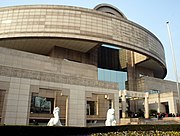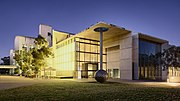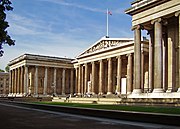Portal:Museums: Difference between revisions
improve two headings |
Anomalocaris (talk | contribs) m properly close <div> |
||
| (6 intermediate revisions by 4 users not shown) | |||
| Line 1: | Line 1: | ||
| ⚫ | |||
{{mfd|help=off}} |
|||
| ⚫ | |||
| ⚫ | |||
{{Portal description}} |
|||
| ⚫ | |||
{{Portals browsebar}} |
{{Portals browsebar}} |
||
__NOTOC__ __NOEDITSECTION__ |
|||
<div style="clear:both; width:100%"> |
<div style="clear:both; width:100%"> |
||
{{Box-header colour| |
{{Box-header colour|<big>The Museums Portal</big>| colour= | mode= }} <!-- |
||
{{Portal image banner|}}--> |
{{Portal image banner|}}--> |
||
{{Transclude lead excerpt|Museums| paragraphs=1-2 | files=1}} |
{{Transclude lead excerpt|Museums| paragraphs=1-2 | files=1}} |
||
| Line 153: | Line 150: | ||
| File:Courtyard of the museum, 2014-12-05.jpg | Small cloister of the charterhouse of [[Santa Maria degli Angeli e dei Martiri]], built on the site of the [[Baths of Diocletian]]; part of the [[National Roman Museum]] of Rome |
| File:Courtyard of the museum, 2014-12-05.jpg | Small cloister of the charterhouse of [[Santa Maria degli Angeli e dei Martiri]], built on the site of the [[Baths of Diocletian]]; part of the [[National Roman Museum]] of Rome |
||
| File:Brama Arbeit Macht frei.jpg | Entrance to [[Auschwitz|Auschwitz I]], part of the [[Auschwitz-Birkenau Memorial and Museum]], a [[Holocaust]] museum on the site of the former [[Nazi concentration camps]] |
| File:Brama Arbeit Macht frei.jpg | Entrance to [[Auschwitz|Auschwitz I]], part of the [[Auschwitz-Birkenau Memorial and Museum]], a [[Holocaust]] museum on the site of the former [[Nazi concentration camps]] |
||
| File: |
| File:Yad Vashem View.jpg | Aerial view of [[Yad Vashem]], Jerusalem, Israel's [[Holocaust]] memorial; the museum, designed by [[Moshe Safdie]], opened in 2005 and tells the personal stories of ninety Holocaust victims and survivors |
||
| File:Air space exhibits 01.jpg | Now closed, the [[California Science Center|California Aerospace Museum]], designed by [[Frank Gehry]], formerly displayed a [[Lockheed F-104 Starfighter]] |
| File:Air space exhibits 01.jpg | Now closed, the [[California Science Center|California Aerospace Museum]], designed by [[Frank Gehry]], formerly displayed a [[Lockheed F-104 Starfighter]] |
||
| File:National Palace Museum Front View.jpg | [[Paifang]] or arched entrance of the Northern Branch of the [[National Palace Museum]], Taiwan, whose collection covers 8,000 years of the history of [[Chinese art]] |
| File:National Palace Museum Front View.jpg | [[Paifang]] or arched entrance of the Northern Branch of the [[National Palace Museum]], Taiwan, whose collection covers 8,000 years of the history of [[Chinese art]] |
||
| Line 280: | Line 277: | ||
{{Wikimedia for portals|species=no|voy=no}} |
{{Wikimedia for portals|species=no|voy=no}} |
||
{{Box-footer}} |
{{Box-footer}} |
||
</div> |
|||
</div> |
</div> |
||
{{Portal navbar no header2}} |
|||
{{portals}} |
|||
{{purge page}} |
{{purge page}} |
||
[[Category:Museums]] |
[[Category:Museums]] |
||
[[Category: |
[[Category:History portals]] |
||
Latest revision as of 06:03, 21 September 2021
A museum is an institution dedicated to displaying and/or preserving culturally or scientifically significant objects. Many museums have exhibitions of these objects on public display, and some have private collections that are used by researchers and specialists. Museums host a much wider range of objects than a library, and usually focus on a specific theme, such as the arts, science, natural history or local history. Public museums that host exhibitions and interactive demonstrations are often tourist attractions, and many attract large numbers of visitors from outside their host country, with the most visited museums in the world attracting millions of visitors annually.
Since the establishment of the earliest known museum in ancient times, museums have been associated with academia and the preservation of rare items. Museums originated as private collections of interesting items, and not until much later did the emphasis on educating the public take root. (Full article...)
The Uffizi Gallery (UK: /juːˈfɪtsi, ʊˈfiːtsi/ yoo-FIT-see, uu-FEET-see; Italian: Galleria degli Uffizi, pronounced [ɡalleˈriːa deʎʎ ufˈfittsi]) is a prominent art museum located adjacent to the Piazza della Signoria in the Historic Centre of Florence in the region of Tuscany, Italy. One of the most important Italian museums and the most visited, it is also one of the largest and best-known in the world and holds a collection of priceless works, particularly from the period of the Italian Renaissance.
After the ruling House of Medici died out, their art collections were given to the city of Florence under the famous Patto di famiglia negotiated by Anna Maria Luisa, the last Medici heiress. The Uffizi is one of the first modern museums. The gallery had been open to visitors by request since the sixteenth century, and in 1769 it was officially opened to the public, formally becoming a museum in 1865. (Full article...)
A Collections Management System (CMS), sometimes called a Collections Information System, is software used by the collections staff of a collecting institution or by individual private collectors and collecting hobbyists or enthusiasts. Collecting institutions are primarily museums and archives and cover a very broad range from huge, international institutions, to very small or niche-specialty institutions such as local historical museums and preservation societies. Secondarily, libraries and galleries are also collecting institutions. Collections Management Systems (CMSs) allow individuals or collecting institutions to organize, control, and manage their collections' objects by “tracking all information related to and about” those objects. In larger institutions, the CMS may be used by collections staff such as registrars, collections managers, and curators to record information such as object locations, provenance, curatorial information, conservation reports, professional appraisals, and exhibition histories. All of this recorded information is then also accessed and used by other institutional departments such as “education, membership, accounting, and administration."
Though early Collections Management Systems were cataloging databases, essentially digital versions of card catalogs, more recent and advanced systems are being used to improve communication between museum staff and to automate and manage collections-based tasks and workflows. Collections Management Systems are also used to provide access to information about an institution's collections and objects to academic researchers, institutional volunteers, and the public, increasingly through online methods. (Full article...)
- ... that a travelling museum exhibition in Japan displays "life-size" renditions of Pokémon skeletons alongside the fossils of actual prehistoric animals?
- ... that Museum Arnhem in the Netherlands celebrated its 100th anniversary with a giant cat picture?
- ... that the British Museum's 2012 exhibition Hajj: Journey to the Heart of Islam included textiles from the Kaaba that were described as bringing "a visceral artistic buzz to the display"?
- ... that the 2024 inductees to the Delaware Sports Museum and Hall of Fame include a man with Down syndrome who has lifted 425 pounds (193 kg), an "average gymnast" turned Olympics judge, a "preeminent sportswriter", the state's "greatest high hurdler", the "inventor" of the modern sports mascot, a record-setting 10-year-old, a champion gymnast, an Olympic field hockey player, and a pro baseball player in five countries?
- ... that the firm of Israel Sack supplied American antiques to leading private collectors and museums, including the Winterthur Museum, The Henry Ford, and the Metropolitan Museum of Art?
- ... that the site of the headquarters of the German colonization of Texas was converted into a museum?
For editor resources and to collaborate with other editors on improving Wikipedia's Museums-related articles, see WikiProject Museums.

A natural history museum or museum of natural history is a scientific institution with natural history collections that include current and historical records of animals, plants, fungi, ecosystems, geology, paleontology, climatology, and more. (Full article...)
Lists
- Museums
- Most visited museums (by region)
- Art museums: most visited, largest
Types
- Art museum
- Agricultural museum
- Archaeology museum
- Architecture museum
- Artillery museum
- Aviation museum
- Biographical museum
- Cabinet of curiosities
- Ceramics museum
- Children's museum
- Community museum
- Computer museum
- Design museum
- Dime museum
- Ecomuseum
- Economuseum
- Ethnographic village
- Farm museum
- Fashion museum
- Folk museum
- Food museum
- Green museum
- Hair museum
- Hall of Memory
- Heritage centre
- Historic house museum
- Human rights museum
- Imaginarium
- Interpretation centre
- Jewish museum
- Lapidarium
- Lighthouse museum
- Living museum
- Local museum
- Maritime museum
- Migration museum
- Mobile museum
- Museum ship
- National history museum
- Natural history museum
- Open-air museum
- Palace museum
- Postal museum
- Prefectural museum
- Print room
- Private museum
- Regimental museum
- Schatzkammer
- Science fiction libraries and museums
- Science museum
- Sex museum
- Sculpture garden
- Technology museum
- Textile museum
- Torture museum
- Toy museum
- Transport museum (list)
- University museum
- Virtual museum
- Wax museum
- Writer's home
Related
The following Wikimedia Foundation sister projects provide more on this subject:
-
Commons
Free media repository -
Wikibooks
Free textbooks and manuals -
Wikidata
Free knowledge base -
Wikinews
Free-content news -
Wikiquote
Collection of quotations -
Wikisource
Free-content library -
Wikiversity
Free learning tools -
Wiktionary
Dictionary and thesaurus






































































